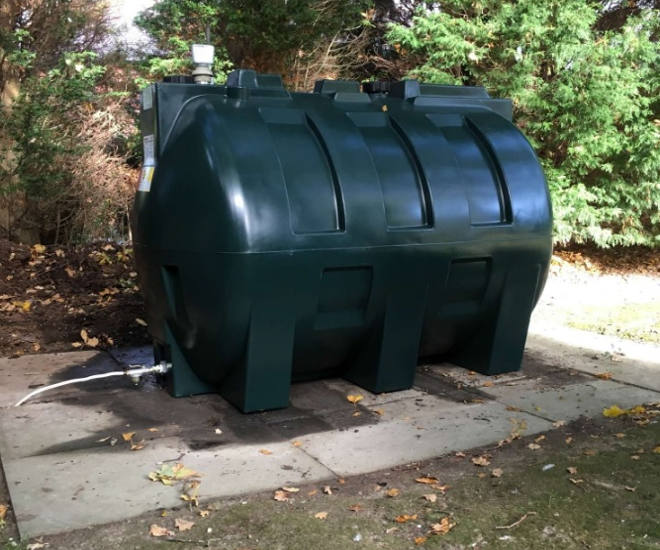
Depending on the space available to you, domestic oil tanks can be positioned outdoors or indoors (including inside garages or outhouses). There are certain restrictions in both instances, to make sure your oil supply is stored safely and doesn’t pose an environmental threat in the event of a leak. Read on for some tips about inside and outside oil tank storage.
Tips for Outside Tank Storage
- Your tank must be positioned on a secure base. If not, the weight fluctuations between an empty tank and a full tank can cause it to shift and settle unevenly, ultimately resulting in added strain to certain parts of the tank. Standing your tank on a concrete block or reinforced patio tiles will keep it sturdy and prolong its life.
- Make sure your tank is located downhill from your house and any outside water sources, to prevent contamination in the event of a leak.
- Keep your tank clear of fences, trees, long grass and foliage. Prolonged contact between damp leaves and the outside of your tank can cause premature corrosion.
- Install your tank away from any gutters or overhanging branches, where a seasonal build-up of leaves or snow can fall and damage it.
- Consider delivery access when choosing an outdoor spot. Your tank should be reachable by supply trucks without blocking or damaging landscaping.
Tips for Storing Indoor Tanks
- Indoor tanks must be stored at the lowest possible level of a building and kept isolated in a one-hour fire-resistant chamber.
- Your tank must be fitted with a secondary containment system, such as an internal bund.
- Any floor drainage within the proximity must be closed, or adjusted in such a way that leaking oil does not pose a risk to nearby water (incoming or waste).
- Ensure your indoor tank can still be easily accessed and inspected from every side, and is at least 1.8m away from any openings (such as windows, doors or vents).
- Install a solid concrete base for indoor tank placement. This helps provide a flat, stable surface and prevents settling or shifting over time.
Factors to Consider When Installing an Outdoor Oil Tank
Installing your oil tank outdoors requires careful planning regarding:
- Accessibility – Ensure supply trucks can easily reach your tank location. Avoid placing it somewhere with obstacles like low trees or narrow side passages.
- Visibility – Position your outdoor tank somewhere discreet but still allow for routine fuel level checks. Avoid blocking sight lines needed for safe monitoring.
- Security – An outdoor tank should be secure and potentially fenced for protection. Determine any risks of tampering or accidental damage from people, wildlife or debris.
- Weather protection – Consider how the weather and climate may impact an outdoor tank for your home. Could it be damaged by snow, ice or strong winds? What about rain or flood risk? If you’re in an area that’s prone to flooding, you may need to bear this mind.
With the right precautions, an outdoor oil tank can be secure, accessible and built to withstand the elements.
Factors to Consider When Installing an Oil Tank Indoors
Placing your oil tank indoors requires evaluating:
- Room size – Measure your room’s dimensions to ensure adequate space for the tank and surrounding access. Account for maintenance access as well and the need to shift an old oil tank away to make room for a newer, replacement oil tank, should that be necessary.
- Concrete base – Ensure that there is a stable, resilient, concrete platform as a foundation for indoor tank stability.
- Ventilation – Indoor tanks need proper airflow to avoid moisture and corrosion. Consult SG Tanks regarding any ventilation requirements you may have about an oil tank inside a segregated room.
- Leak containment – Use leak containment products to avoid spills indoors. Pans, mats and alarms can all provide protection.
- Appearance – Disguise indoor tanks with partitions or enclosures if needed – as they are not the most eye-catching features of a home. Alternatively, integrate them neatly into utility rooms.
With some planning, indoor oil tank installations can be safe, subtle and optimised for home fuel supply.
Should I Keep My Domestic Oil Tank Indoors or Outdoors?
When deciding on oil tank placement, weigh the pros and cons of indoor versus outdoor oil tank installation. Factor in accessibility, ventilation, visual appeal and ease of monitoring when choosing the best location. Be sure to also account for the need for oil tank repairs should something go wrong down the line, and decide whether it’s best to have it accessible in an indoor or outdoor location. Adopt this same mindset when considering the need to replace your oil tank, should that be needed.
With the right spot, your oil tank can operate safely and effectively for years to come.
If you’re not sure whether to store your tank indoors or outdoors, our team of experts can carry out a survey and provide a professional recommendation. Contact us today for more information.

